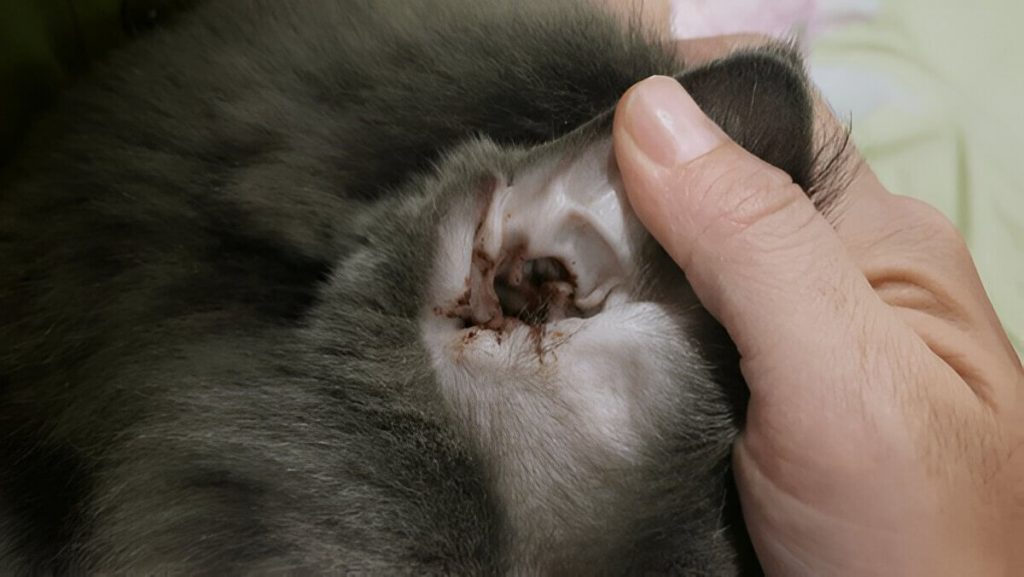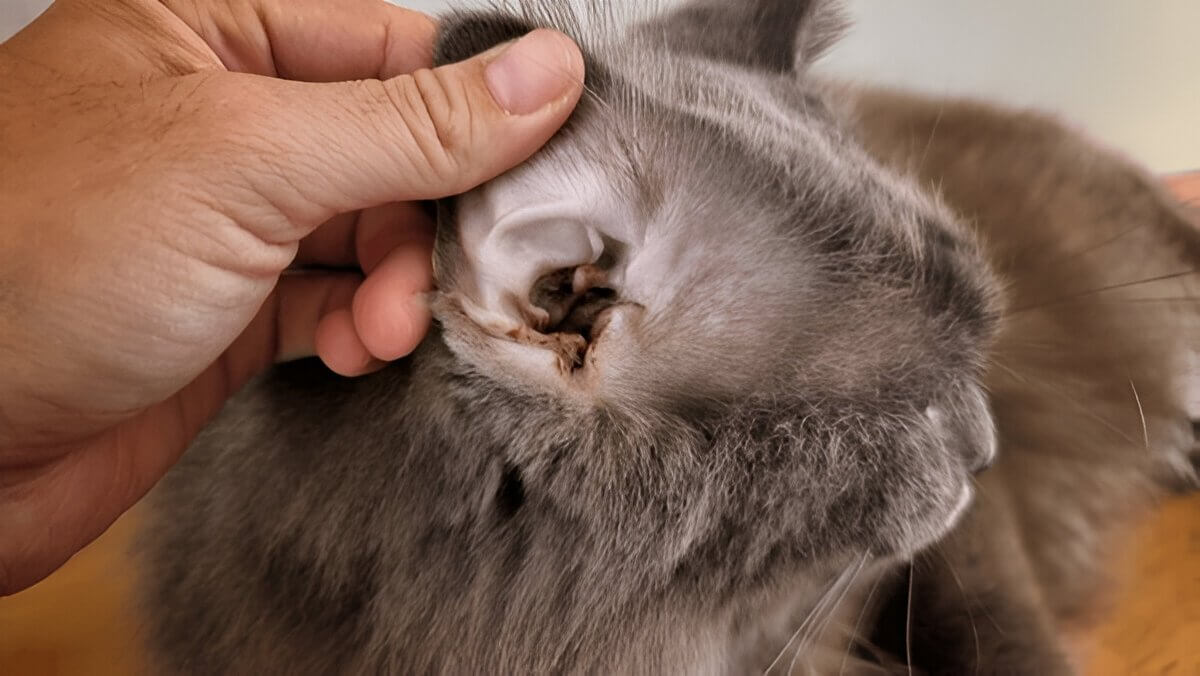Mites. These microscopic creatures are a common problem for cats, leading to discomfort and irritation. Ear mites feed on the wax and oils in a cat’s ears, often resulting in symptoms such as intense itching, redness, and inflammation. If left untreated, these parasites can cause more severe issues like ear infections or even damage to the eardrum.
Feline ear mites are highly contagious and can easily spread from one animal to another through direct contact. This is why multi-pet households often face challenges when dealing with these pests. Understanding the lifecycle of these cat ear parasites is crucial for effective treatment and prevention. Typically, they have a three-week lifecycle during which they reproduce rapidly within the warm environment of a cat’s ear.
Recognizing the signs of an infestation early on can help mitigate potential complications. Regular vet check-ups and maintaining good hygiene practices are essential steps in managing this common feline issue effectively. By staying informed about ear mites in cats, pet owners can ensure their furry friends remain healthy and comfortable.
Identifying the Symptoms of Ear Mites in Cats
Ear mites are a common issue among cats and can cause significant discomfort if left untreated. Recognizing the symptoms of ear mites in cats is crucial for early intervention and effective treatment. One of the most noticeable signs is excessive scratching at the ears, as an infected cat will often try to relieve the intense itchiness caused by these tiny parasites. Additionally, you might observe your cat shaking its head frequently or tilting it to one side.
Other symptoms include a dark, crumbly discharge resembling coffee grounds in the ear canal, which is a telltale sign of ear mite infestation. This discharge results from a combination of wax buildup and mite debris. Cats with ear mites may also exhibit redness or inflammation in their ears due to irritation.
If you notice these signs of ear mite infection (such as your cat persistently scratching its ears or displaying other unusual behaviors related to its ears) it’s important to consult with a veterinarian promptly. Early diagnosis and treatment can prevent more severe complications and ensure your feline friend returns to comfort quickly.
The Life Cycle and Transmission of Ear Mites
Ear mites, specifically Otodectes cynotis, are a common parasitic infestation in cats that can cause significant discomfort if left untreated. Understanding the life cycle and transmission of these tiny pests is crucial for effective prevention and treatment.
The life cycle of Otodectes cynotis begins when adult mites lay eggs inside the ear canal of a host animal. These eggs hatch into larvae within four days, subsequently maturing into nymphs. Over the course of three weeks, these nymphs develop into adult mites capable of reproduction, perpetuating the cycle. This rapid development means that infestations can quickly become severe if not addressed promptly.
Transmission of ear mites primarily occurs through direct contact between animals. Cats often get ear mites from close interactions with other infested animals such as dogs or rabbits, particularly in environments like shelters or multi-pet households where close proximity facilitates the spread. Indirect transmission is less common but can occur via contaminated bedding or grooming tools.
Being informed about how cats get ear mites and understanding their life cycle can help pet owners take proactive measures to protect their furry companions from this uncomfortable condition. Regular veterinary check-ups and maintaining a clean environment are key steps in preventing mite infestations and ensuring your cat’s ears remain healthy and free from irritation.
Diagnosing Ear Mite Infections

When you suspect your feline friend might be suffering from ear mites, a visit to the vet is essential for an accurate diagnosis and effective treatment plan. Diagnosing ear mites in cats involves a thorough veterinary examination, where the vet will look for signs that indicate the presence of these pesky parasites.
During the examination, the vet will first perform a visual inspection of your cat’s ears. Ear mites often cause inflammation and irritation, leading to symptoms such as redness, excessive scratching, or dark discharge resembling coffee grounds. These are telltale signs that your vet will look for during their initial assessment.
To confirm the presence of ear mites, vets commonly use an otoscope to get a closer view inside your cat’s ears. This instrument allows them to see any live mites or eggs nestled within the ear canal. In some cases, they may also take a sample of the ear debris and examine it under a microscope—this method is highly effective in detecting even small numbers of mites.
By understanding how vets detect ear mites through these diagnostic methods, pet owners can feel reassured knowing that their furry companions are receiving comprehensive care tailored to address this common yet uncomfortable condition effectively.
Treatment Options for Eradicating Ear Mites in Cats
When it comes to addressing ear mite infestations in cats, there are several effective treatment options available that cater to different needs and preferences. Understanding these options can help you choose the best course of action for your feline friend.
The most common treatment for a cat’s ear mite infestation involves using medications specifically designed to eliminate these pesky parasites. Topical solutions, such as selamectin or moxidectin, can be applied directly to the skin and are highly effective in eradicating ear mites. These medications not only target the mites but also help relieve irritation and inflammation caused by their presence.
For those who prefer a more holistic approach, there are several home remedies that may provide relief for a cat’s itchy ears. One popular method is using mineral oil or olive oil to gently clean the cat’s ears. This helps smother the mites and soothe any discomfort your pet may be experiencing. However, it’s crucial to consult with a veterinarian before trying any home remedies to ensure they are safe and suitable for your specific situation.
In some cases, oral medications might be recommended by veterinarians as part of an integrated treatment plan. These systemic treatments work from within and can be particularly useful if topical applications alone do not resolve the issue.
Regardless of which option you choose, it’s essential to follow through with regular check-ups and maintain good ear hygiene practices for your cat. This helps prevent future infestations and ensures your pet remains healthy and comfortable. Always consult with a veterinarian before starting any treatment plan to ensure it is appropriate for your pet’s needs.
Preventing Future Infestations
As a cat owner, ensuring your feline friend remains healthy and comfortable is a top priority. One common issue that can cause discomfort for cats is ear infections, often caused by pesky ear mites. These tiny parasites can lead to irritation, inflammation, and if left untreated, more severe health issues. To help you in preventing cat ear infections and keeping your pet mite-free, here are some practical tips to avoid recurrence of ear mite problems.
Firstly, regular cleaning of your cat’s ears is essential. Use a vet-approved ear cleaner to gently clean the inside of their ears once a week or as recommended by your veterinarian. This routine not only helps in removing dirt and wax build-up but also keeps the environment less hospitable for mites.
Secondly, maintain a clean living environment for your pet. Regularly wash bedding and vacuum areas where your cat spends most of its time. This reduces the risk of mites hitching a ride into their ears from contaminated surfaces.
Additionally, consider using preventive treatments such as topical medications or oral preventatives specifically designed to keep parasites at bay. Consult with your veterinarian to choose the best product suited for your cat’s needs.
Finally, monitor your pet closely for any signs of discomfort such as excessive scratching or head shaking. Early detection is key in preventing minor issues from escalating into larger problems.
The Importance of Regular Veterinary Check-Ups and Cleaning Routines
Regular veterinary check-ups are crucial for maintaining your cat’s health and well-being. Routine vet visits for cats’ health maintenance not only help in early detection of potential health issues but also ensure that your feline friend receives timely vaccinations and preventive care. These visits allow veterinarians to monitor your cat’s overall condition, offering insights into diet, behavior, and any changes that might need attention.
An often-overlooked aspect of feline care is ear hygiene. Cleaning your cat’s ears regularly is essential to prevent parasites and infections. Cats are prone to ear mites and other ear-related problems, which can lead to discomfort or more serious conditions if left untreated. Establishing a regular ear care routine can help mitigate these risks.
Here are some ear care routine tips: Begin by gently inspecting your cat’s ears for any signs of redness, excess wax, or unusual odors; these could indicate an underlying issue. Use a vet-recommended solution to clean the ears safely without causing irritation. Be gentle and patient; this will help make the process less stressful for both you and your pet.
Incorporating these practices into your regular pet care regimen ensures that you’re doing everything possible to keep your cat healthy and happy. Regular vet check-ups combined with diligent at-home grooming routines form the foundation of effective feline healthcare management.
Ensure Your Cat ’s Comfort by Staying Informed About Their Health Needs
In conclusion, ensuring your cat’s comfort and well-being hinges on staying informed about their health needs. As a responsible pet owner, it’s crucial to recognize that cats, like humans, require regular healthcare and attention to thrive. Regular veterinary check-ups are essential for monitoring your cat’s health and catching any potential issues early. Understanding the signs of common feline ailments can empower you to act swiftly should any concerns arise.
Moreover, maintaining a balanced diet tailored to your cat’s specific nutritional requirements is vital for their overall health. Cats are obligate carnivores, meaning they need certain nutrients found primarily in animal products. Providing high-quality food that meets these dietary needs is key to preventing nutritional deficiencies.
Additionally, creating a stimulating environment with plenty of opportunities for play and exercise will contribute significantly to your cat’s physical and mental well-being. Remember that each cat is unique; factors such as age, breed, and lifestyle will influence their specific health needs.
By staying informed through reliable sources (whether through veterinary advice or credible online resources) you can ensure that you’re providing the best possible care for your feline friend. Your proactive approach not only enhances their quality of life but also strengthens the bond you share with them.
